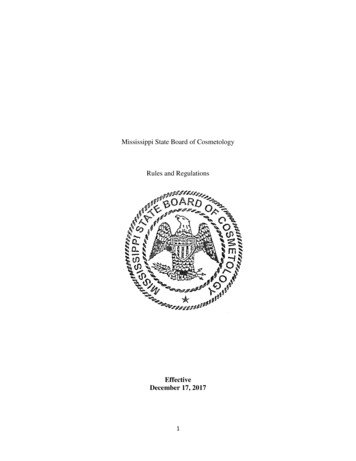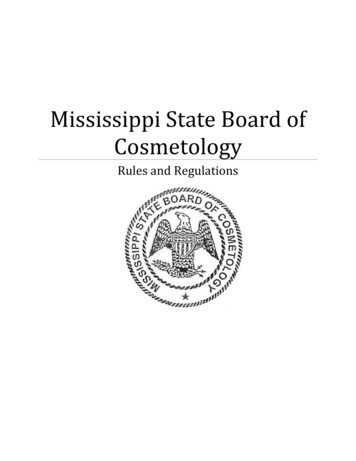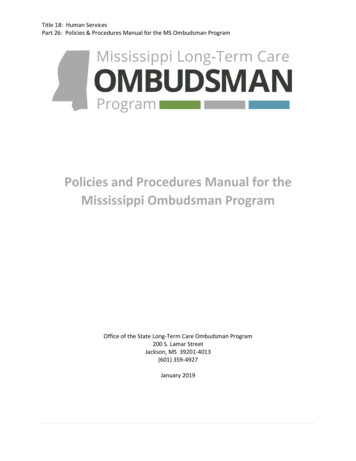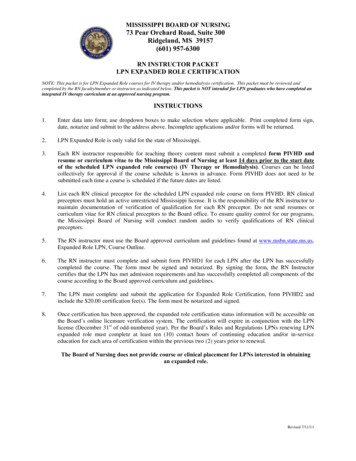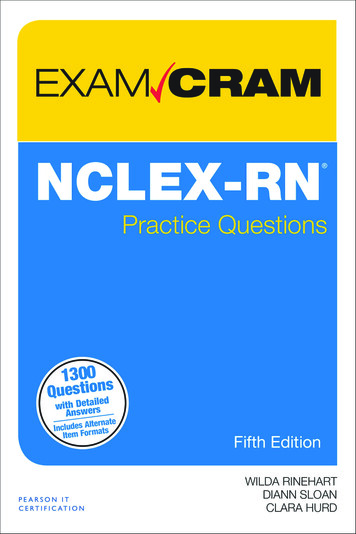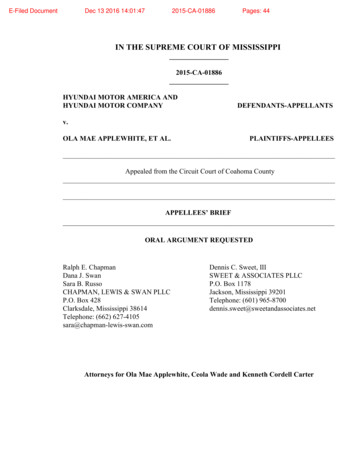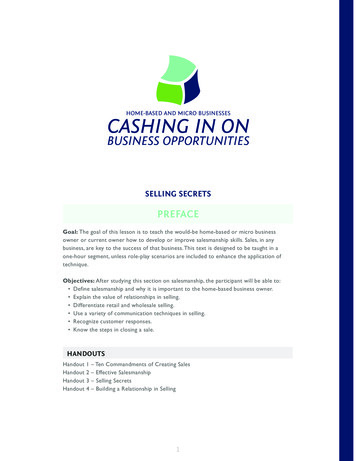
Transcription
SELLING SECRETSPREFACEGoal: The goal of this lesson is to teach the would-be home-based or micro businessowner or current owner how to develop or improve salesmanship skills. Sales, in anybusiness, are key to the success of that business. This text is designed to be taught in aone-hour segment, unless role-play scenarios are included to enhance the application oftechnique.Objectives: After studying this section on salesmanship, the participant will be able to: Define salesmanship and why it is important to the home-based business owner. Explain the value of relationships in selling. Differentiate retail and wholesale selling. Use a variety of communication techniques in selling. Recognize customer responses. Know the steps in closing a sale.HANDOUTSHandoutHandoutHandoutHandout1234– Ten Commandments of Creating Sales– Effective Salesmanship– Selling Secrets– Building a Relationship in Selling1
ADDITIONAL RESOURCESAlessandr, A.T.,Wexler, P., Barrera, R., & Alessandra, T. (1992). Non-Manipulative Selling. NewYork: Prentice Hall Press.Brabec, B. (1997). Homemade Money (5th ed.). Cincinnati, OH: Betterway Books.Evanson, D. R., Fisher, J., Griffin, C. E., Kanarek, L., Kennedy, D., McGarvey, R., & Weinstein, B.(1996, Mar.). 10 best ways to. Entrepreneur Magazine, 102-111.Withy, J. J. & Panitz, E. (1995, Aug.). Face-to-face selling: Making it more effective. IndustrialMarketing Management, 24, 239-246.2
SELLING SECRETSINSTRUCTIONAL MATERIALSSELLING DRIVES THE BUSINESSSelling is the backbone of any business. The success of your business is totally dependenton your ability to sell not only goods and services, but yourself as well. As possibly the onlysalesperson in the business, you make the business visible. You create the business imagethe customer sees; you are the salesperson. Whether you are selling products or services,you are the critical link between product and service. You become the expert that satisfiescustomer needs and wants.3Salesmanship is described as the ability to understand customer needs and wants. It requiresbeing able to translate those needs and wants into a product or service that can be sold.Though the product or service from your business is important, your actions and attitudeswith customers, as you learned earlier, create an image of the business in the customer’smind. These images distinguish your business from others. Selling is part of that image.Selling occurs as long as you are in contact with the customer—directly or indirectly.Salesmanship is on the line continually in a home-based business. Family members whomay be involved in the business in some way are also salespeople. Or you may have paidemployees. How they treat customers is part of the selling process. Be certain they aretrained in selling and customer service techniques because first impressions are important.If you employ a sales person, be certain he or she is knowledgeable of what is being soldand has a commitment to making the sale. You must be concerned with not only what isbeing sold, but to whom, how many, needs of customers, where they are and how you willreach them. Today’s entrepreneur should also be concerned with cultural differences incustomers and selling situations.Salesmanship is at the heart of your efforts to succeed. Many people owning a home-basedbusiness are in business because they love creating a product or providing a service. Theybelieve people want their product or service because they are “good” or “creative.” Smallbusiness owners generally dislike selling; they would prefer that customers simply want theproduct. However, owners as well as employees should know the steps in the selling processand learn and practice those skills.12WHO ARE SUCCESSFUL SALES PEOPLE?4Some of the same characteristics that describe successful entrepreneurs also describegood sales people: energetic, friendly, motivated, persistent, knowledgeable of product, goodcommunicators, and problem solvers. Some of the most essential qualities of successful salespeople include: Expect positive results Believe in the business, product and one’s self Quick thinking3
Effective manager of self and timeRespectable appearanceAble to handle rejectionproblem-solverCourageous (ask for the sale)DeterminedGood listenerSelf-starterPersonal and caring attitudes are effective tools in increasing the chance for successful selling.With increasing competition for the consumer’s dollar, home-based business owners shouldcheck personal attitudes that can affect their salesmanship. Paul and Sarah Edwards, authorsof Secrets of Self Employment, state that having a serious business attitude is essential forbeing taken seriously as a home-based business. A marginal business attitude hampers theowner’s ability to sell himself or herself as a really viable business. They cite five signals thatindicate an owner may have a marginal business attitude: Working only when the owner wants to, if at all. Claiming lack of money as reason for not doing what needs to be done to make thebusiness successful. De-valuing the products and services sold by charging too little. Disliking the challenge of sole ownership. Trying to be everything to everyone.5Take yourself and your business seriously. Remember that even the best product cannotmake up for a poor business attitude.RECOGNIZING SELLING SITUATIONS6Where and how do you sell what you produce or provide? There are two types of sellingsituations—direct and indirect selling. Which type you are in depends on whether thebusiness sells directly to consumers or to other businesses.Direct selling is known as personal selling. It is used in retail businesses where you selldirectly to consumers. Indirect selling is conducted in wholesale situations and involvesan impersonal approach. You are selling to a business that will re-sell the product directlyto the consumer. Regardless of the type of product or service you are selling, your aim isto generate enough sales to stay in business and make a profit. Perhaps you just love whatyou’re doing; however, you must also close sales to cover your costs to maintain a business.Do not be shy or embarrassed about searching for or creating situations to sell yourproduct.BUILD SALES RELATIONSHIPS7Relationships with customers play a critical role in successful salesmanship. Ruth and Wysokisuggest the relationship between customer and owner should be the focus of business4
SELLING SECRETSrather than the sales. To build customer relations and the potential for sales, ask questions,observe customers, and respond to their wants and needs. The skilled salesperson listens tothe meaning of what people are saying and is alert to cues that signal the chance to close asale. Take a keen interest in your customer to build trust.48910A relaxed communication style in sales can create a welcoming image in the mind of aprospective buyer. This style establishes credibility, conveys competence and instills asense of trustworthiness. Though communication style cannot predict sales success, it cancontribute to a positive relationship with the customer and greater potential for sales.Good business communication brings in customers by communicating a favorable andaccurate image of your business. The home-based business owner must be prepared to domore than produce a product or service. They must believe in their product or service andbe willing to convince potential customers to do the same.According to Ken Blanchard, co-author of Raving Fans, it is necessary to go a step beyondyour competitors by “taking care of your customers to the point they become raving fansand want to brag about you.” Salesmanship is more than closing the final sale; it is everythingyou do on behalf of the business, including opportunities to network with potential clients,competitors, vendors, and resources for your business.Selling is everything you do on behalf of the business.NETWORKING EQUALS CONTACTS/POTENTIAL SALESAccessing customers for the home-based business owner is critical to create contacts withpeople who know others. This technique is called networking and involves salesmanshipskills in communicating with others about your business. Without it, the home-basedbusiness remains invisible. Networking creates potential leads that can develop into sales.Creating prospective contacts and potential sales requires the effective salesperson (homebased business owner) be knowledgeable of local events and news, talk with existingcustomers, follow up on former customers, read newspapers and trade journals as wellas related publications. Home-based business sales people should follow up on leads, askquestions, and get referrals as a regular part of networking.11Networking extends your contacts to locate services that can help you in your business orinitiate the interest of contacts that do not know about your products and services. Twotypes of networks can improve your salesmanship abilities. The first is formal networkswhere people from trade or professional associations with similar business interests cometogether. One example is the local Chamber of Commerce. This type of association allowsyou to establish your credibility in the business community. The second type of networkingis informal networks that involve other people with other businesses, such as owners, salespeople, and even competitors.Effective networking, like good salesmanship, demands the person be professional. Goodbusiness communication brings in customers and saves you time and money because youare communicating a favorable and accurate image of your business. Networking means you5
must be prepared by knowing as much as you can about the groups you network with andhow you can answer questions about your business.12BUILD YOUR SELLING SKILLSSelling requires several skills that can be learned. Sources indicate the first step indeveloping salesmanship skills is to get organized. Know your customer, your product, thevalue of that product for the customer, your competitors, and your own resources. Have aclear idea of what you sell. Know why your product would be valuable to a customer.Another key selling skill involves anticipating selling situations before actually encounteringthem. Talking to other owners about their experiences, networking with a variety ofbusinesses, and anticipating what to expect and how you will react can build selling. Practiceon a spouse or friend. These selling skills can be learned. Know what to expect, whether theencounter is face to face or phone to phone. Selling requires the person to be adaptable toa variety of situations, making the most of opportune times to encourage customer loyaltyand increase sales volume. Flexibility is an important characteristic in adaptive selling. Indealing with a variety of cultural groups, effective sales people adjust to different culturalnorms, including negotiation and communication styles. It is advisable to learn as much asyou can about other cultures. It can also be valuable to study different temperaments andbe aware of how people respond to different situations. Also, it is important to alwaysbe on the lookout for new sales. Always have a sales plan and continuously look for newcustomers or ways to keep current customers satisfied. The best time for selling is whenyou are already meeting the financial needs of your business.STEPS IN CLOSING A SALE13Salesmanship implies you make sales and earn profit. A poorly handled transaction candestroy sales. Customers remember negative transactions and uneasy sales people. Thoughyou may be uncomfortable selling, you can sell regardless of your personality. Skills of sellingcan be learned.There are seven steps to the selling process: prospecting, preparing, approaching,presentation, dealing with objections, closing the sale, and follow-up.1. Prospecting is the step of developing lists of customers. These are generated fromcontacts, direct efforts of advertising, or through networking to meet potential customers.2. Preparation is the attempt to gain as much information about potential customers aspossible.3. The sales approach is the initial opportunity to make a positive impression. Relationshipsoften begin with this stage.4. Sales presentation is intended to hold the attention of the customer. It should be apersuasive presentation on the benefits of the product or service. Every attempt should bemade to maintain focus on the customer, involving the customer and conveying enthusiasm6
SELLING SECRETSfor the business and the product. A good sales presentation will enable a customer toidentify with your product.145. Dealing with objections or rejection is often difficult for the novice salesperson. Beprepared to analyze customer objections. Objections tend to fall into five categories:no need, no hurry to buy, no trust, no money to buy, and no desire to buy. Anticipateyour reaction to those objections; role-play how to respond to customers. Maintainingcomposure and anticipating objections without raising them is desirable. Other techniquesfor overcoming objections include asking the customer questions, giving the customerconfidence that his interest is well directed, or directing the customer to other featuresor benefits that may be more appealing. Experts in sales training indicate it takes threequestions to get customers to get to the real (and usually emotional) reason for consideringa purchase.No need may mean you have not offered the potential customer a reason to buy fromyou. It’s up to you to create that need. If the customer indicates he is in no hurry to buythe product, then it is up to you to provide an incentive to make the purchase. It may be amatter of providing an extra service that makes the product more valuable.Customers who state they just don’t have any money right now may actually not be willingto spend as much money as you are asking. Consider different payment methods or ways toadd value to your product.When you are selling a product or service through the mail, the Web, or other remotemethod, the customer needs to know that you and your product are to be trusted. You mayneed to provide some evidence, such as references from other pleased customers, yourresume, or samples of your product or service.The final objection, no desire, is difficult to overcome. You may have to listen morecarefully to learn of other objections, offer other alternatives, or ask more questions. Ifthat customer truly has no desire to purchase, then ask for referrals to other potentialcustomers.156. Closing the sale can occur any time during the objection phase. Make positive suggestions;assume the sale is complete. Offer an incentive to make the purchase. Summarize benefitsthat appeal to the customer, remembering the emotional motivation. Stress your desire forthe customer to be satisfied. Finally, do not overlook asking the customer for an order.Many sales have been lost by the inexperienced owner because he talks too much. Therecomes a time in selling that you just have to quit talking. Recognition of that time arriveswhen the customer himself indicates he is ready to close the deal, either verbally or nonverbally. Some of these situations present themselves in clear messages: the person takesout a credit card or checkbook, or actually states, “I’ll take it.” If the cues are less clear, askfor the sale. Sum up the benefits and features of your product or service. The salespersonmust be an astute listener and analyst and be prepared to offer alternative solutions tonegative selling situations.7
The most overlooked part of salesmanship is that the salesperson forgets the “ask.” It doesnot matter how well you learn the client or how well you can overcome the objections. Ifyou do not ask for the sale, it probably will not happen.Just remember that salesmanship is more than just making one sale. The home and microbusiness, like any business, depends on regular sales, typically to ongoing customers, to stayin business. Therefore, it is important to spend time getting to know the customer, his orher needs, and how you can be an important element in the business.Good salesmanship requires knowledge of one’s self, knowledge of the product and servicebeing sold, and knowledge of customers. Salesmanship demands attention to relationships,planning to maximize networking opportunities, and communicating so others canunderstand you.7. Lastly, do not forget to follow up with the customer after a sale is made.REFERENCESBlanchard, K. & Bowles, S. (1993). Raving Fans: A revolutionary approach to customer service.New York: William Morrow.Edwards, P. & Edwards, S. (1996). Secrets of self-employment. New York: G.P. Putnam and Sons.Wold, D.P., & Riggenbach, D. (1996). NxLeveL guide for business start-ups. Denver, CO: U.S.West Foundation.Ruth, A, & Wysoki, A. (n.d.). Top sellers: characteristics of a superior salesperson. Extension,University of Florida. Retrieved from http://edis.ifas.ufl.edu/SN004Thornhill, K., Wysocki, A., Tomlinson, R. How to effectively reduce sales call reluctance.Extension, University of Florida. Retrieved from http://edis.ifas.ufl.edu/SN011Walker, D.K., & Mark, E. (n.d.). Finding the connections: how to create and use apersonal network. School of Family Studies and Human Services Research and Extension,Kansas State. Retrieved from SS/KSUpersonalnetwork2.pdfGLOSSARYCustomer. The person who purchases the products and services of a business.Marginal business attitude. Attitudes that impair the ability of an owner to create aviable business.12-9 Networking. Communicating with people in a variety of social and professionalsituations.Relationship marketing. The idea that the relationship with the customer endures longerthan the sale of the product or service.Retail. Selling directly to the end-user of the product or service, the consumer.Salesmanship. The ability to understand customer needs and wants and translate thoseneeds and wants into a product or service that can be sold.Selling situations. Retail or wholesale situations in which goods or services areexchanged for money.Serious business attitude. Attitudes that encourage an owner to create a viable business.Wholesale. Selling to a company that will, in turn, sell the product or service to theultimate user, the consumer.816
SELLING SECRETSROLE-PLAYING EXERCISESObjective: learning to overcome objectionsRoles:One home-based business owner/or micro business ownerCustomer1.Situation: looking at the home-based business owner’s product or service portfolio.What would you say to the person if he indicated he was unsure if the product/service was what he wanted?Possible solutions:Service/product with other characteristicsDifferent delivery/service termsMore customized needs2.Situation: Owner is at a wholesale or retail trade show. A customer is looking at theproduct at a wholesale or retail trade show.How would you approach the customer? What would you say to, “I’m just looking”?Role play your responses to:I really don’t need this. (no need)I’m not in a hurry to buy this. (no hurry)I don’t know yet. (no trust)I don’t have any money right now. (no money)I really don’t want that. (no desire)Role play closing the sale (refer to Slide 13).Create statements that suggest, offer, summarize, approve, and ask.Prepared by Pamela J. Brown, Assistant Professor and Extension Specialist, Texas A&M UniversitySystems, College Station, TX, Aug. 1997.9
HANDOUT 1TEN COMMANDMENTS OF CREATING SALES1.A CUSTOMER . IS THE MOST IMPORTANT PERSON IN ANY BUSINESS2.A CUSTOMER. DOES NOT DEPEND ON THE BUSINESS; THE BUSINESSDEPENDS ON THE CUSTOMER3.A CUSTOMER. IS NOT AN INTERRUPTION TO WORK; HE IS THE PURPOSE OFIT.4.A CUSTOMER. IS PART OF THE BUSINESS, NOT AN OUTSIDER.5.A CUSTOMER. DOES THE BUSINESS A FAVOR WHEN HE CALLS. THE BUSINESSIS NOT DOING HIM A FAVOR BY BEING THERE.6.A CUSTOMER. IS A REAL PERSON WITH FEELINGS VERY MUCH LIKE MY OWN.7.A CUSTOMER. DOES NOT WANT TO ARGUE OR MATCH WITS WITH ME.8.A CUSTOMER. IS A PERSON WHO BRINGS HIS WANTS—IT IS THE JOB OF THEBUSINESS TO FILL THEM.9.A CUSTOMER. DESERVES THE BEST AND MOST COURTEOUS SERVICE THEBUSINESS CAN GIVE.10. A CUSTOMER. IS THE ONE WHO MAKES IT POSSIBLE FOR THE BUSINESS TOEXIST.Adapted by Pamela J. Brown, Assistant Professor and Extension Specialist,Texas A&M UniversitySystems from materials developed by Dennis O. Fisher, Professor and Extension Economist, Texas A&MUniversity Systems, College Station, TX, Aug. 1997.10
HANDOUT 2EFFECTIVE SALESMANSHIPBe aware of your attitude - make it positive.Avoid these negative attitudes - They leave lasting impressions on the customer: Working only when you want to. Failing to BE THERE for the customer. Not servicing the customer. Undercharging for your services. Avoiding challenges. Trying to be all things to all people .Communicate clearly about the purpose and image of your business. Know your strengths and weaknesses. Be willing to learn. Network with other business people and potential customers. Be adaptable to a variety of customers and situations. Relax while talking to customers. Listen with your mind and body. Make eye contact. Be friendly and keep it simple. Watch your customers’ mannerisms.Create trust with customers to develop long-term relationships that involve more thanone sale.Sell the value of your product or service rather than the product/service itself.Anticipate selling situations.Prepare yourself for possible customer responses.Developed by Pamela J. Brown, Assistant Professor and Extension Specialist, Texas A&M UniversitySystems, College Station, Texas, Aug. 1997.11
HANDOUT 3SELLING SECRETS. Be completely familiar with the product/service.Have a strong desire to sell.Be neat and well groomed.Be familiar with customers’ needs and wants.Show enthusiasm, energy, imagination, and initiative.Listen to customers; show interest.Practice role playing to anticipate situations.Ask your customer questions, and listen to the answers.Developed by Pamela J. Brown, Assistant Professor and Extension Specialist, Texas A&M UniversitySystems, College Station, TX, Aug. 1997.12
HANDOUT 4BUILDING A RELATIONSHIP IN SELLING.Six principles of non-manipulative selling:PROFESSIONALISMYOU’RE KNOWN BY THE WAY YOU HANDLE YOUR BUSINESS.SHARED GOALSTHE DESIRE TO DO BUSINESS IS STRONGER THAN THE DETAILS.TRUSTBUILD RELATIONSHIPS THAT ARE OPEN/HONEST.UNDERSTANDINGLISTEN AND LEARN FIRST.APPRECIATIONCUSTOMERS NEED AFFIRMATION AND ACCEPTANCE, NOT JUST THE PRODUCT.PARTNERINGSOLVE PROBLEMS WITH THE CUSTOMER, NOT FOR THE CUSTOMER.13
Use a variety of communication techniques in selling. Recognize customer responses. Know the steps in closing a sale. HANDOUTS Handout 1 – Ten Commandments of Creating Sales Handout 2 – Effective Salesmanship Handout 3 – Selli


